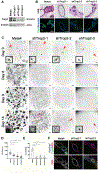Trop2 is upregulated in the transition to dysplasia in the metaplastic gastric mucosa
- PMID: 32432338
- PMCID: PMC8010636
- DOI: 10.1002/path.5469
Trop2 is upregulated in the transition to dysplasia in the metaplastic gastric mucosa
Abstract
Intestinal-type gastric adenocarcinoma arises in a field of pre-existing metaplasia. While biomarkers of cancer and metaplasia have been identified, the definition of dysplastic transition as a critical point in the evolution of cancer has remained obscure. We have evaluated Trop2 as a putative marker of the transition from metaplasia to dysplasia in the stomach in multiple mouse models of metaplasia induction and progression. In addition, TROP2 expression was evaluated in human samples by immunostaining tissue microarrays for metaplasia, dysplasia, and gastric cancer. Dysplastic mouse organoids were evaluated in vitro following shRNA knockdown of Trop2 expression. In mouse models, no Trop2 was observed in the normal corpus and Trop2 was not induced in acute models of metaplasia induction with either L635 or DMP-777. In Mist1-Kras mice, Trop2 expression was not observed in metaplasia at 1 month after Kras induction, but was observed in dysplastic glands at 3-4 months after Kras induction. In human tissues, no Trop2 was observed in normal corpus mucosa or SPEM, but Trop2 expression was observed in incomplete intestinal metaplasia, with significantly less expression in complete intestinal metaplasia. Trop2 expression was observed in all dysplastic and 84% of gastric cancer lesions, although expression levels were variable. Dysplastic mouse organoids from Mist1-Kras mice expressed Trop2 strongly. Knockdown of Trop2 with shRNA markedly reduced organoid growth and budding behavior, and induced the upregulation of apical villin expression. We conclude that Trop2 is upregulated in the transition to dysplasia in the stomach and promotes dysplastic cell behaviors. © 2020 Pathological Society of Great Britain and Ireland. Published by John Wiley & Sons, Ltd.
Keywords: CD44 variant 9; SPEM; Tacstd2; dysplasia; gastric cancer; intestinal metaplasia; metaplasia.
© 2020 Pathological Society of Great Britain and Ireland. Published by John Wiley & Sons, Ltd.
Conflict of interest statement
Figures





References
-
- Ferlay J, Soerjomataram I, Dikshit R, et al. Cancer incidence and mortality worldwide: sources, methods and major patterns in GLOBOCAN 2012. Int J Cancer 2015; 136: E359–386. - PubMed
-
- Bray F, Ferlay J, Soerjomataram I, et al. Global cancer statistics 2018: GLOBOCAN estimates of incidence and mortality worldwide for 36 cancers in 185 countries. CA: a cancer journal for clinicians 2018; 68: 394–424. - PubMed
-
- Schmidt PH, Lee JR, Joshi V, et al. Identification of a metaplastic cell lineage associated with human gastric adenocarcinoma. LabInvest 1999; 79: 639–646. - PubMed
Publication types
MeSH terms
Substances
Grants and funding
LinkOut - more resources
Full Text Sources
Medical
Molecular Biology Databases
Research Materials
Miscellaneous

